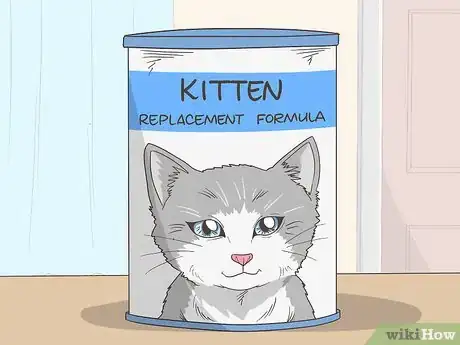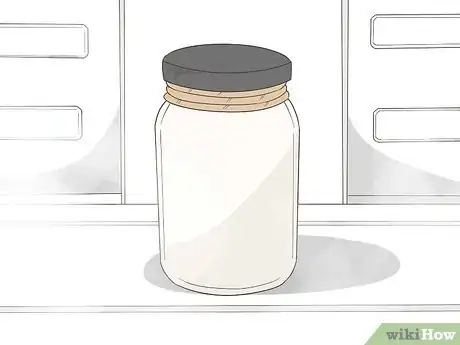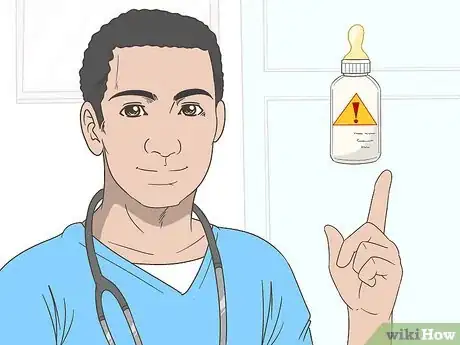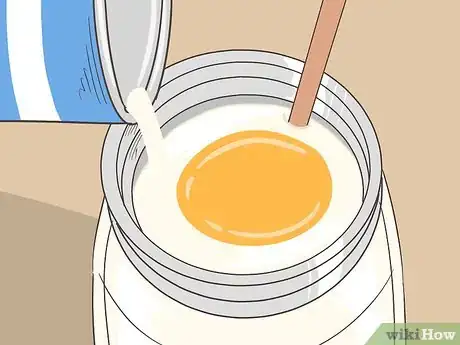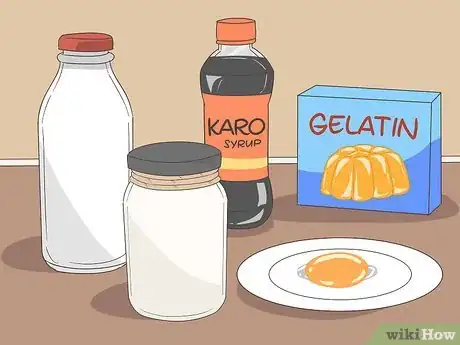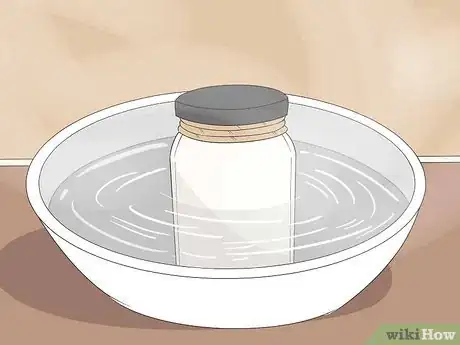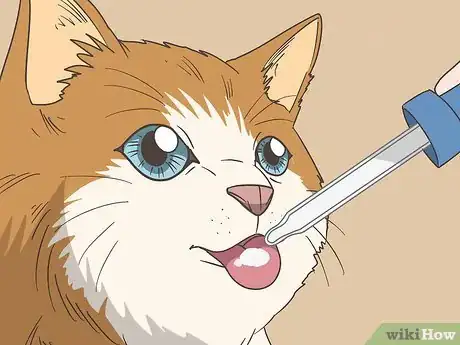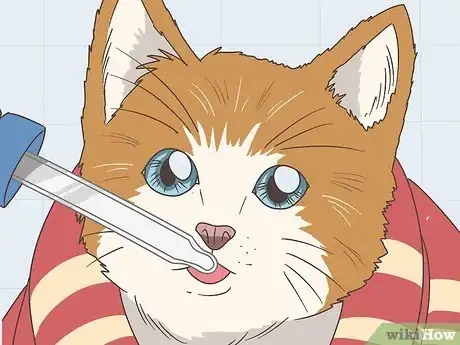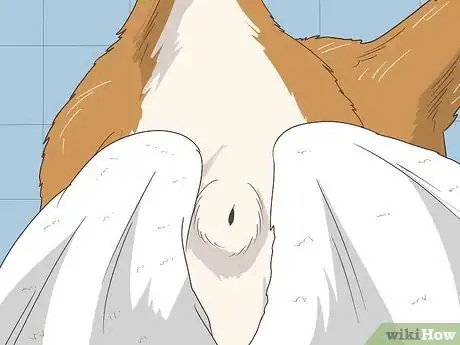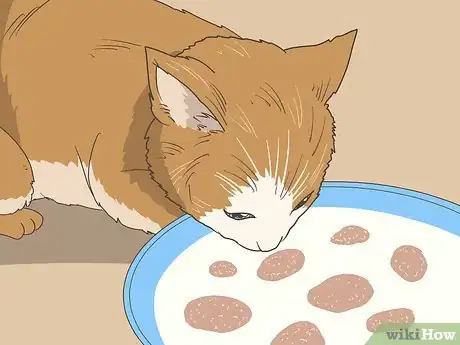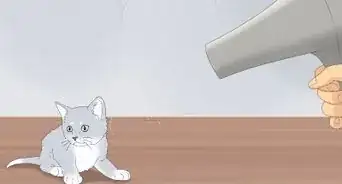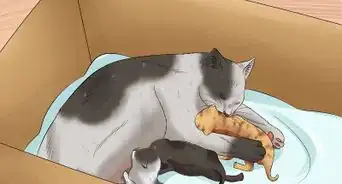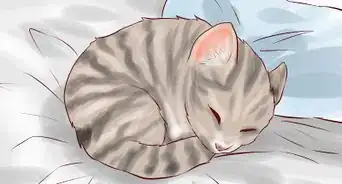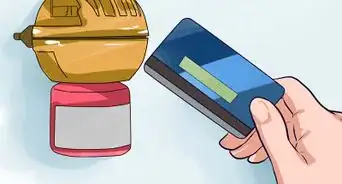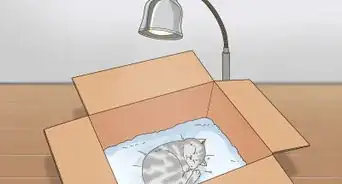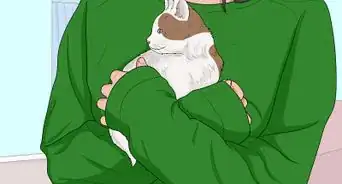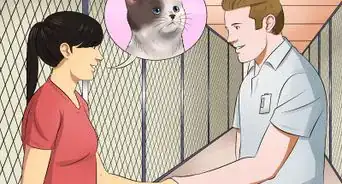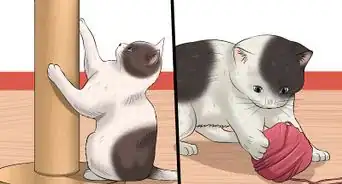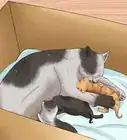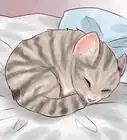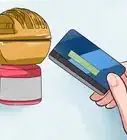This article was co-authored by Pippa Elliott, MRCVS and by wikiHow staff writer, Danielle Blinka, MA, MPA. Dr. Elliott, BVMS, MRCVS is a veterinarian with over 30 years of experience in veterinary surgery and companion animal practice. She graduated from the University of Glasgow in 1987 with a degree in veterinary medicine and surgery. She has worked at the same animal clinic in her hometown for over 20 years.
This article has been viewed 63,303 times.
Finding an orphaned kitten can be scary, and you probably want to do everything you can to help the kitten thrive. You can feed the kitten by making homemade formula in an emergency, but it’s not safe to give it homemade formula for more than a few days. Homemade formula isn’t nutritionally complete, so you need to get a commercial kitten replacement formula from your vet or a pet store. Feed your kitten every 3 hours for the first week, then gradually lengthen the time between feedings.
Steps
Using Commercial Replacement Formula
-
1Purchase kitten replacement formula from a vet or pet store. Kitten replacement formula is sold in powdered and liquid form. Powdered formula is better for your kitten than liquid formula because it’s less likely to cause diarrhea. Ask your vet to recommend or prescribe a formula, or look for 1 at your local pet store.[1]
- Liquid formula typically doesn’t need to be mixed with water. However, keep in mind that the kitten is more likely to have diarrhea when it eats liquid formula. Since diarrhea can dehydrate your kitten, it may become life-threatening.
- Check the expiration date to make sure the formula isn’t expired. Never give a kitten expired formula because it can make the kitten sick.
- Some good brands of kitten formula include PetAg KMR Powder and Farnam Pet Products Just Born Highly Digestible Milk Replacer for Kittens.
-
2Measure a serving of powdered formula and mix it with water. Read the label to find out how much powdered formula to use for 1 serving. Then, measure out the formula and put it into a clean bowl or jar. Add water according to the label and stir to combine.[2]
- Your formula may come with a scoop to make measuring it easy. Otherwise, use a measuring spoon.
Tip: Use unflavored Pedialyte instead of water for the first 24 hours to limit the risk of the kitten getting diarrhea.
Advertisement -
3Store the formula in your refrigerator to prevent it from spoiling. Kitten formula will go bad if you don’t keep it cool. This can make your kitten very sick, which will likely require veterinary care. Keep it in the refrigerator when you’re not using it.[3]
- To check if the formula is spoiled, sniff it to make sure it smells like sweet milk. If it smells rancid or like bad cooking oil or old cheese, it is likely spoiled.
Mixing a Homemade Formula
-
1Use a homemade formula only as a last resort. Homemade formulas are not nutritionally complete, and sometimes they can do more harm than good. However, if you have a hungry orphaned kitten and there’s no way to get a commercial kitten milk replacement (KMR) formula right away, you can use one of these as a short-term option.
- If possible, contact a vet or go to an emergency vet clinic to get some KMR.
- Some vets recommend giving only water to keep the kitten hydrated until you can get KMR.
- Homemade formulas may cause diarrhea, which can lead to dehydration in kittens.
-
2Mix an egg yolk into unsweetened evaporated milk for a quick option. Pour a small can of unsweetened evaporated milk into a jar. Then, add an egg yolk to the milk and stir to combine. Refrigerate the formula until you’re ready to use it.[4]
- Don’t use sweetened evaporated milk because it can harm the kitten.
- Your formula should stay fresh in the refrigerator for 1 or 2 days, so you can use it for multiple feedings.
Warning: This formula is only safe to use for 1 day of feedings. It’s a quick, emergency option until you can get a nutritionally complete formula.
-
3Use whole milk, egg yolks, and olive oil as another quick option. Pour 8 fl oz (240 mL) of whole milk into a jar. Then, add 2 egg yolks and 1 tsp (4.9 mL) of olive oil to the jar. Stir the ingredients to combine them. Store the formula in the refrigerator until you’re ready to use it.
- You can also add 1 drop of liquid pediatric vitamins if you have them.
- The formula should stay fresh in the refrigerator for 1-2 days.
-
4Combine goat’s milk, Karo syrup, yogurt, egg yolks, and gelatin for more nutrition. Pour 1 qt (0.95 L) of goat’s milk into a saucepan. Then, mix in the correct amount of Knox unflavored gelatin for the kitten’s age. Heat the ingredients on low heat until the gelatin dissolves. Finally, add 1 tsp (4.9 mL) of light Karo syrup, 1 US tbsp (15 mL) of plain nonfat yogurt, and 1 egg yolk to the mixture and stir to combine them. Store the formula in the refrigerator until you’re ready to use it.
- It’s best to use goat’s milk yogurt for the formula, but you can use regular plain nonfat yogurt if that’s all you have.
- Goat’s milk formula will stay fresh in the refrigerator for up to a week.
Tip: This formula is more nutritionally complete than other homemade formulas. However, it’s not safe to use it for more than a few days. The kitten needs a kitten replacement formula to make sure it thrives.
Feeding the Kitten
-
1Make sure the kitten is warm before you feed it. If the kitten is cold, it won’t be able to digest the formula properly. Before you begin feeding, feel the kitten’s ears and paw pads, or gently put your finger in its mouth. If any of these parts of its body feel cold, wrap the kitten in a towel or baby blanket and cuddle it close to your body. While you’re snuggled up with the kitten, rub it with warm hands to gradually warm it up over about 20 minutes.[5]
- If the kitten eats while it is cold, the formula will stagnate in its digestive tract and make it ill.
- Don’t try to warm up the kitten too quickly (e.g., with a heating pad or electric blanket), since a sudden change in temperature could be harmful. Warm it up gradually using a towel or blanket and your own body heat.
-
2Warm up the formula by placing the container in hot water. Put the formula into a small cup or jar. Fill a large bowl with hot water, then immerse the bottom of the cup or jar under the water. Leave the cup or jar in the water until the formula feels warm to the touch.[6]
- As an alternative, hold the bottom of the cup or jar under a stream of running hot water. This will quickly warm it up.
- Test the formula with your finger to make sure that it’s not too warm. It should feel slightly warmer than room temperature.
Warning: Never microwave formula because it can create hotspots that may scald the kitten.
-
3Use an eye dropper or needle-less syringe to administer the formula. Place the tip of the eye dropper or syringe into the warm formula. Then, draw the formula up into the dropper or syringe until it’s nearly full. Place the tip of the eye dropper or syringe into the kitten’s mouth to feed it.[7]
- You can get an eye dropper or syringe from your vet or a local pet store.
Variation: You can also use a nursing bottle, but keep in mind that kittens usually can’t suck the formula out of the nipple. You’ll likely need to squeeze the nipple or the bottle to help the kitten eat.
-
4Squeeze the formula into the kitten’s mouth. Hold the tip of the eye dropper or syringe in your kitten’s mouth. Slowly squeeze a few drops of formula onto the kitten’s tongue. Wait for the kitten to swallow the formula, then squeeze a few more drops into its mouth. Stop feeding the kitten when it refuses food or its stomach looks like a football.[8]
- It’s okay if the kitten only eats a little bit of food at a time. Don’t try to force it to eat because it may get diarrhea if it overeats. Instead, offer it food more often.
-
5Feed the kitten every 3 hours for the first 1-2 weeks. Kittens need constant care when they’re very young. Offer the kitten food every 3 hours for the first week you’re caring for it. This will ensure that it gets enough food to help it thrive.[9]
- It’s best to ask your vet how often you need to feed the kitten. If the kitten is already several weeks old, you might be able to feed it less often. Similarly, if the kitten is very small, your doctor may recommend feeding it more often.
-
6Switch to feeding every 4 hours for the third week. Once you’ve been carrying for the kitten for a week or 2, it’s okay to reduce the number of feedings because the kitten should be eating more food at each feeding. Space your feedings at 4-hour intervals for the third week.[10]
- If you continue to formula feed the kitten longer than 3 weeks, space the feedings out to every 5-6 hours.
- Check with your vet before changing the feeding schedule.
-
7Massage the kitten’s anus with a warm towel after it eats to help it potty. A young kitten can’t urinate or defecate on its own, so you have to help it potty after each feeding. Wet a paper towel with warm water. Hold the kitten over paper towels, then gently wipe the kitten’s anal and urinary openings with the towel. It should immediately potty. Afterwards, pat the kitten’s anal and urinary area dry.[11]
- Continue to help the kitten potty until it’s able to do it on its own.
-
8Start weaning the kitten at 3-4 weeks of age. Once the kitten starts biting or chewing the dropper, syringe, or nipple, it’s safe to start weaning. To wean the kitten, mix the formula into kitten food so the kitten recognizes the taste. Then, smear the food on the kitten’s mouth and let it lick the food off. Place a bowl of food mixed with formula in front of the kitten and monitor it while it eats.[12]
- Mix formula or water into the food for the first 2-3 weeks of weaning. Then, switch to wet or dry kitten food when the kitten is 6 or 7 weeks of age.
Warning: Don't leave the kitten unattended while it's eating the formula and food mix. It may fall into the bowl.
Warnings
- Don’t give the kitten cow’s milk because it won’t be able to digest it properly.⧼thumbs_response⧽
- Take the kitten to the vet if it doesn’t eat for 6 hours. It may get dehydrated, which can be life-threatening.[14]⧼thumbs_response⧽
References
- ↑ http://www.animalalliancenyc.org/wordpress/2013/05/what-to-do-and-not-do-if-you-find-a-newborn-kitten/
- ↑ http://www.animalalliancenyc.org/wordpress/2013/05/what-to-do-and-not-do-if-you-find-a-newborn-kitten/
- ↑ http://www.animalalliancenyc.org/wordpress/2013/05/what-to-do-and-not-do-if-you-find-a-newborn-kitten/
- ↑ https://www.petmd.com/cat/centers/kitten/adoption-getting-a-kitten/evr_ct_orphaned_kitten_care
- ↑ http://www.animalalliancenyc.org/wordpress/2013/05/what-to-do-and-not-do-if-you-find-a-newborn-kitten/
- ↑ https://www.petmd.com/cat/centers/kitten/adoption-getting-a-kitten/evr_ct_orphaned_kitten_care
- ↑ https://www.petmd.com/cat/centers/kitten/adoption-getting-a-kitten/evr_ct_orphaned_kitten_care
- ↑ https://www.petmd.com/cat/centers/kitten/adoption-getting-a-kitten/evr_ct_orphaned_kitten_care
- ↑ http://www.animalalliancenyc.org/wordpress/2013/05/what-to-do-and-not-do-if-you-find-a-newborn-kitten/
- ↑ http://www.homeatlastrescue.org/html/aboutcats/kittencare.html
- ↑ https://www.petmd.com/cat/centers/kitten/adoption-getting-a-kitten/evr_ct_orphaned_kitten_care?page=2
- ↑ https://www.petmd.com/cat/centers/kitten/nutrition/evr_ct_weaning_kittens_what_to_feed_a_kitten
- ↑ https://www.petmd.com/cat/centers/kitten/adoption-getting-a-kitten/evr_ct_orphaned_kitten_care
- ↑ https://www.petmd.com/cat/centers/kitten/adoption-getting-a-kitten/evr_ct_orphaned_kitten_care
